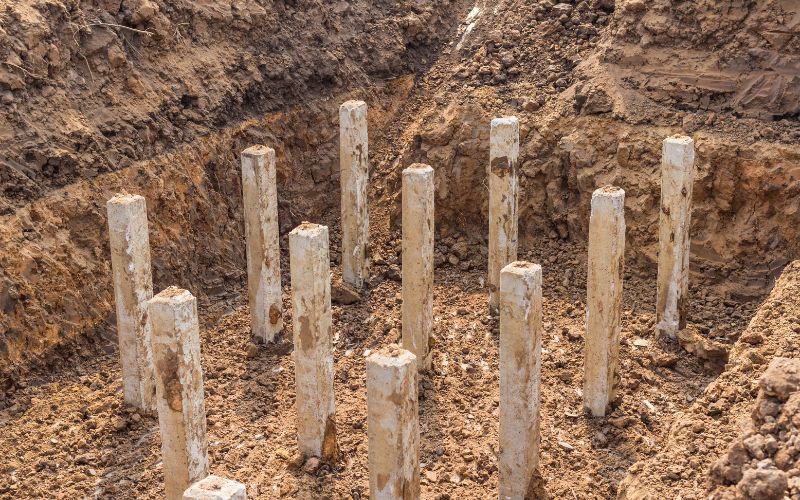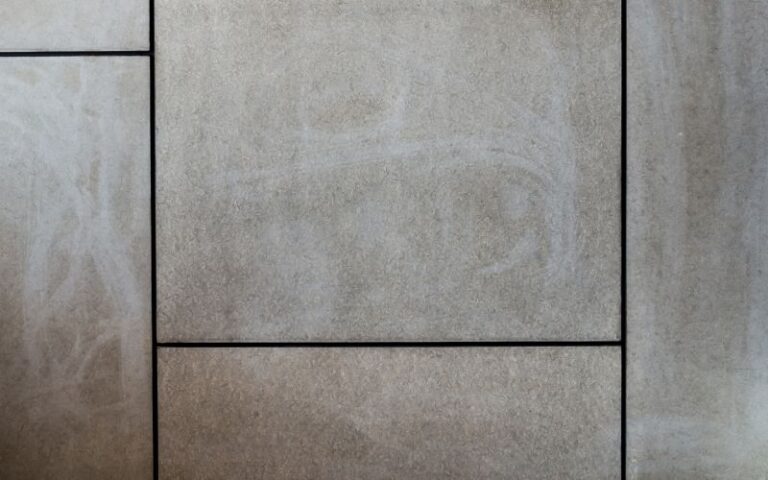A Pinned foundation is a pile load-bearing foundation consisting of a series of pillars driven into the ground to support a building or structure.
Pinned or deep foundations are best used on muddy and waterlogged soil with poor draining ability.
There are special situations where pinned or fixed foundations are used; engineers select one of them based on construction requirements and the soil composition.
Pinned foundations are used to support bridges, towers, and skyscrapers. The special ability of pinned foundations to support high-point load-bearing structures makes it a good choice. They are also cheaper in some cases than other types of foundations.
Ready for a Flooring Quiz?
What Is a Pinned Foundation?

Pinned Foundation, also known as a deep foundation, is a type of foundation that uses vertical beams or trenches driven or dug deep into the ground.
Deep foundations are a top choice for constructors in areas where the topsoil is loose or is too hard. Soils like this hinder the effectiveness and safety of shallow foundation types.
Buildings like skyscrapers, towers, and bridges benefit from pinned foundations’ high-point load-bearing capabilities.
Shallow foundations have wider bases that spread force evenly, leading to creeping and cracking on soils with uneven density.
Here are some of the characteristic pinned foundations and some of their special properties.
#1. Consumes Less Concrete
It is no surprise that shallow foundations consume a lot of cement and concrete.
Deep foundations focus most of their load on the soil, unlike shallow foundations that spread it out evenly on the ground.
Shallow foundations like concrete slabs use lots of concrete and building materials.
Deep foundations are reinforced steel beams, concrete poles, or wooden beams. These materials reduce the amount of concrete needed to construct foundations.
#2. It Doesn’t Require Heavy Excavation
Constructing shallow foundations requires heavy machinery like dredgers to excavate large amounts of topsoil.
Deep foundations like pinned foundations require a series of vertical tunnels to be dug and the foundation beams installed.
#3. Has Good High Point-Load Bearing Capacity
Tall and heavy structures like skyscrapers concentrate their weight on a relatively small area of land.
Deep foundations have a very good point-load-bearing capacity compared to shallow foundations.
Their ability to withstand such forces makes them a good choice for constructing multi-story foundations.
#4. Less Damage To the Environment
If you have been to a construction site, you will notice how it affects the environment and topsoil around the area.
Shallow foundations upturn large amounts of topsoil and mess up the environment. Deep foundations affect the environment the least as there is a lower amount of excavation going on.
How Strong Is a Pinned Foundation?
Pinned foundations are tough enough to withstand loads weighing hundreds of thousands of tons. Pinned foundations can support heavy loads, but they support heavy point loads better.
There are multiple foundations today, but they can all be grouped into shallow and deep foundations.
Here are some examples of shallow and deep foundations.
| Shallow Foundation | Deep Foundation |
|---|---|
| Spread Foundation | Basement Foundation |
| Strip foundation | Pile foundation |
| Raft foundation | Shaft foundation |
| Concrete slab foundation | Pile foundation |
#1. Concrete Slab Foundation
A concrete slab foundation is made by casting a slab of concrete that rests on the ground. Slab foundations are sturdy and provide a good base for small to relatively tall buildings.
Slab foundations are cheap to construct, and they are popular in tropical regions where there are temperature extremes.
#2. Pile Foundation
Pile foundations use long beams or cylinders of concrete or steel as supports.
Pile foundations have very good point load support abilities and can transfer the weight of buildings into the ground. Pile foundations are mostly used as the foundations of skyscrapers and piers.
#3. Basement Foundation
A basement foundation is a type of foundation that is dug deep to accommodate an extra room underground.
Basement foundations are mostly used in bungalows and family homes. They can improve the amount of space in a building and provide shelter against tornados and other natural disasters.
#4. Pier Foundation
Pier foundations are foundations with large cylindrical columns that transfer the force of heavy loads deep into the ground.
Pier foundations save a lot of money as they do not require lots of concrete and excavation work. Pier foundations perform a good job protecting structures from flooding.
Is a Pinned Foundation Expensive?
Pinned or Deep foundations are less expensive to construct than other types of foundations.
Deep foundations require smaller amounts of concrete and do not disturb the soil as much as shallow foundations do. The cost of constructing pinned foundations depends on several different factors.
#1. Type of Foundation
Shallow foundations consume large amounts of building materials and concrete. Foundations that take up a large amount of space to construct are costly to build.
High-rise buildings, bridges foundation, and large building complex foundations are some of the most expensive.
#2. Depth of the Foundation
The height of the building affects the depth of the foundation being used. Smaller buildings have shallow foundations, while taller buildings have deeper foundations that provide better support.
#3. Climate
The climate of an area can also affect the cost of constructing a foundation. Places that experience natural disasters like monsoons, hurricanes, and tornadoes must have strong and durable foundations.
Their foundations are built to be thicker, deeper, and more resilient than foundations in calmer climates and are thus more expensive.
#4. Type of Soil
Soils that are loose, hard, or soggy complicate building foundation construction. Engineers must spend extra time and money preparing the soils in such areas for constructors.
Soils that can support the weight of the building use shallow foundations, while soils that are too saturated employ deeper foundations.
Pinned Foundation VS. Fixed Foundation
Pinned foundations and fixed foundations are foundations that support different types of buildings better.
Let us look at the advantages and disadvantages of pinned and fixed foundations.
#1. Advantages of Pinned Foundation
- Can be driven easily
- Bear heavy loads
- Can penetrate deeply
- Great for loose soils
#2. Disadvantages of Pinned Foundation
- More expensive
- Piles can get deformed or broken during storage and installation
- It can be expensive sometimes
#3. Advantages of Fixed Foundation
- Quick construction times
- Structural stability
- Can withstand flooding and bad weather conditions
#4. Disadvantages of Fixed Foundation
- Uses more construction materials
- Fixed foundations like slabs are colder during winter
- Requires lots of excavation work to be done
Selecting a pinned foundation for your building can save you a lot of money in construction material and labor costs.
But this does not mean fixed foundations are not good. Fixed Foundations are the best foundation for constructing houses and apartment complexes.
Conclusion
Civil engineers will choose pinned or fixed building foundations based on several factors.
Factors like soil density, type of building, and environmental factors will influence the foundation chosen.
The foundation chosen will affect how the building handles problems like waterlogged soil and natural disasters. It would be best if engineers used the proper foundation for structures.






